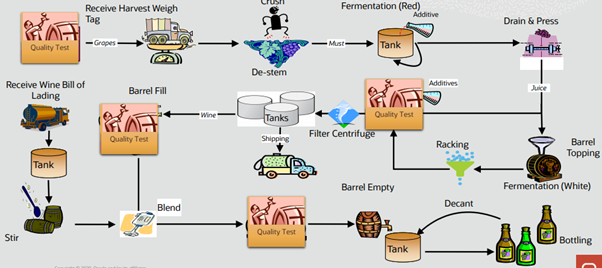
Importance of JDE EnterpriseOne
in Blend Management Solution
Increasing global competition, mergers, acquisitions, and innovations in the wine-making industries are forcing winemakers to seek fully integrated business automation solutions based on ERP systems to improve operational effectiveness and efficiency. Winery businesses have received many awards for implementing blend management solutions in their operation.
Blend management solution with ERP system protect the brand quality, reduced administrative burdens also reduced system and duplicate data. Cyret technology is a platinum partner of Oracle and worked with the different wine-making companies by implementing an award-winning JD Edwards EnterpriseOne Blend Management solution. Mainly this solution addresses the production requirement of the Agri- beverage industry.
Blend management is a web-based system that features blend product manufacturing that provides end-to-end traceability including the tracking of solid details from every part of your blending operations. JD Edwards EnterpriseOne Blend Management system track and manage blocks and their yields, the receiving information of grapes, processing and blending, also bulk receipts and transfers. The JD Edwards EnterpriseOne Blend Management system enables you to customize and control blend facilities, lots, vessels, and operations also helps to overcome challenges like growing complexity of blend business, operational effectiveness and efficiency, lack of real-time visibility, manual identification of repeatable processes, lack of quality control visibility, etc
Below are few advantages of the implementation of JD Edwards EnterpriseOne in Blend Management System to overcome the above challenges:
- The improved technical architecture of the blend system for optimized dependency chain performance and scalability
- Reliable performance of the blend system when adding and updating blend operations
- Efficient roll-forward and recalculations by using currently available system resources
- Barrel inquiry application re-written to rapidly display data and add to a new toolbar
- Real-time operation execution

The main Component of the JD Edwards EnterpriseOne Blend Management are Blend facilities, vessels, lot attributes, blend operations, quality assurance testing, as well as costing and accounting. Let’s have a look at how automation helps in these components and make ways easy for wine producers.
Blend Facility
The blending facility represents the business unit that you need for accounting purposes and provides constants that serve as default values for activities associated with the winery. Providers can determine the next number of schemes for operations, work orders, and bills of lading by setting up the following information that is associated with the facility:
- Work areas where activities are performed.
- Staff who perform blend-related tasks.
- Workgroups to which you can assign staff.
- Equipment that you need for the blending process, and dry goods (consumables) that are consumed by the equipment but do not affect the blend lot attributes.
- Weight-to-volume conversion rates on a global, facility, and variety level
vessels
Blending processes use tanks and barrels to hold the blend lots on which operations can be performed. For the tank, characteristics can be defined such as calibration, storage capacity dip chart (the system uses to convert height measurement into volume). For barrel profile, the provider can set a barrel profile as template characteristics that can use when setting up barrels in the system or purchasing barrels. Also, define styles for barrels that indicate the effect of the barrel on the blend lot stored in the barrel. Group of barrels represents virtual barrel tanks (VBT), which consist of one or many barrels.
Lot Attributes
Lot attributes can be set up to track changes in the blend lot as a result of the blend operation process. Lot attributes include end-use reservation (EUR), ownership, style, composition, material type, wine status, blend ID, accumulated additives, summary and instructed attributes, as well as lot comments, lot costs, and quality test results. The system enables not only to displays lot attributes, but also to calculate values based on specific lot attribute values and display them. Lot Management can predict child entity attributes, summary attributes, lot blending, also track and track operations.
Quality Management
The blending process requires ongoing quality assurance activities. JD Edwards EnterpriseOne Quality Management system to set up test definitions, test result names to similar group tests with different test definitions, and test panels to group tests that are performed together. For tests we can also set up sample containers to be used when taking samples, also set up equipment and consumable material that are needed to perform tests.
Costing and Accounting
JD Edwards EnterpriseOne Blend Management use to enable costing and accounting for defining cost components for the materials which are going to use in the blending process. for example, the equipment that is using for quality tests, can track the cost for EURs and owners by setting up appropriate accounting groups. When close operations are put into use the system creates journal entries to account for the costs of Before and After lots, as well as additives and consumables. JD Edwards EnterpriseOne resolves incidences of performance problems when adding or updating into blend operations. The enhancements extend the blend system’s ability to maintain relationships between operations and vessels throughout the winemaking process. Also increases user productivity, and therefore adds significant value for blend customers.
Wrapping Up
Cyret Technologies has extensive expertise in JD Edwards EnterpriseOne which makes us your trusted partner for JD Edwards E1 support solution. Cyret’s Team of Experts not only conduct the initial audit to understand the structure of your company but also provides you the right and valuable dedicated support, shared support, or managed support services options which helps your company to manage your day-to-day operations with top quality resources in a very cost-effective way and utilize your internal resources to focus on business growth.
Frequently Asked Questions
As part of the Blend Management process, constants are provided that are the default values for activities associated with the winery. Since blending is a complex process, each step must be monitored and facilitated by advanced technology. It focuses on tracking lot attributes from the source of supply through to the bottled finished product with a goal of driving process repeatability, label integrity, and award-winning results. JD Edwards EnterpriseOne Blend Management is a solution that addresses the production requirements of the Agri-beverage industry. Also, you can perform quality assurance testing, costing, accounting, and import blend related information from another system.
EUR stands for "Product Allocation" or "Purpose Use." It's when a blend lot or a block is assigned to one or more end products. This is mostly used for supply and demand analysis, as well as planning. For example, part of a blend lot could be intended for producing a high-end wine, whereas the remaining lot quantity goes into the production of a wine of lesser quality. A EUR is also used to manage assets by product, brand, or product family, so the system can manage assets by product, brand, or product family. EURs can represent products, product blends, or product families. Also, we can assign lot and blocks to an EUR as a percentage or as Fixed volume.
Defining the EUR profile allows for product consistency. By having product specifications, protocols, and planning criteria aligned with EUR, QA is enabled before Blend Management can be used. Furthermore, the JDE QA module must be activated before Blend Management can be used The QA module needs to set up the quality tests you will conduct on the blend lot as well as the equipment and consumables you will use during the test. Also, we can specify how long test results will remain valid. Additionally, you can group testes into panels and test results into test results name.
In some cases, the information is required for legal reasons, while in others, it is used for accounting purposes or to track the lot as it is blended. It can be used to identify the status of the blend before or after blending, as well as identify the bulk material's origin or variety and harvest period. When JDE is implemented, Lot Attribute End-Use Reservations (EURs) are defined. EURs are then defined according to the harvest season thus enabling adjustment of EURs during the new harvest period. In some companies, for example, EURs may be set up once every year. Similar EURs may be subordinate to a parent EUR, for instance, if a Cabernet EUR is used in several Cabernet end lots.
It is sometimes difficult to streamline the work order execution process. But with Winery – the tasks are either grouped or sequentially done. The record reservation function of JDE allows you to maintain integrity of vessel & operation information. To organize work performed by a group of employees in a particular area, you can associate operations with work orders. Work orders can also be created from templates by grouping operations that are commonly performed together or in sequence.

